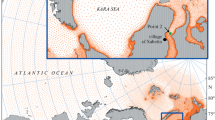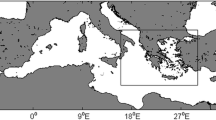Abstract
The results of wind wave hindcast for the Caspian Sea for the period of 1979–2017 are presented. The WAVEWATCHIII wave model and wind forcing from the NCEP/CFSR reanalysis are used. The modeling is performed on the unstructured grid with the spacing to 1 km in the coastal zone. Mean and extreme values of wave height, length, and period are provided. It is shown that the maximum height of waves of 3% probability of exceedance is 11.7 m. The interannual variability of wave parameters is analyzed. No unambiguous trend towards increase or decrease in the storm activity was revealed over the hindcasting period.
Similar content being viewed by others
References
A. K. Ambrosimov and S. A. Ambrosimov, “Wave Characteristics for the Deep Part of the Central Caspian Sea Derived from Observations in Different Seasons of 2005 Using Wave-Tide Gages,” Ekologicheskie Sistemy i Pribory, No. 8 (2008) [in Russian].
A. K. Ambrosimov and S. A. Ambrosimov, “Experimental Studies of Wind Waves in the Central Caspian Sea,” Ekologicheskie Sistemy i Pribory, No. 10 (2008) [in Russian].
F. N. Gippius, V. S. Arkhipkin, and A. V. Frolov, “Seasonal Variations in Evaporation from the Caspian Sea Surface with Account of Wind Waves and Sea Depth,” Vestnik Moskovskogo Universiteta. Seriya: Geografiya, No. 5 (2016) [in Russian].
V. V. Efimov, O. I. Komarovskaya, and V. A. Naumova, “Statistical Estimation of Reanalysis Wind Data Based on Data of Wind Observations at Weather Stations on the Northern Coast of the Black Sea,” in Environmental Control Systems (MGI, Sevastopol, 2004) [in Russian].
N. I. Ivkina and A. V. Galaeva, “Forecasting Wind Waves in the Caspian Sea with the SWAN Model,” Gidrometeorologiya i Ekologiya, No. 2 (2017) [in Russian].
The Caspian Sea: Hydrology and Hydrochemistry, Ed. by S. S. Baidin and A. N. Kosarev (Nauka, Moscow, 1986) [in Russian].
A. V. Kislov, G. V. Surkova, and V. S. Arkhipkin, “Occurrence Frequency of Storm Wind Waves in the Baltic, Black, and Caspian Seas under Changing Climate Conditions,” Meteorol. Gidrol., No. 2 (2016) [Russ. Meteorol. Hydrol., No. 2, 41 (2016)].
A. Yu. Medvedeva, V. S. Arkhipkin, S. A. Myslenkov, and S. S. Zilitinkevich, “Wave Climate of the Baltic Sea Simulated with the SWAN Spectral Model,” Vestnik Moskovskogo Universiteta. Seriya 5: Geografiya, No. 1 (2015) [in Russian].
A. Yu. Medvedeva, S. A. Myslenkov, I. P. Medvedev, V. S. Arkhipkin, V. A. Krechik, and S. A. Dobrolyubov, “Numerical Modeling of Wind Waves in the Baltic Sea using the Rectangular and Unstructured Grids and the NCEP/CFSR Reanalysis,” Trudy Gidromettsentra Rossii, No. 362 (2016) [in Russian].
S. A. Myslenkov, V. S. Platonov, P. A. Toropov, and A. A. Shestakova, “Simulation of Storm Waves in the Barents Sea,” Vestnik Moskovskogo Universiteta. Seriya 5: Geografiya, No. 6 (2015) [in Russian].
S. A. Myslenkov, E. V. Stolyarova, M. Yu. Markina, S. V. Kiseleva, V. S. Arkhipkin, A. A. Gorlov, and P. M. Umnov, “Seasonal and Interannual Variability of Wave Energy Flux in the Barents Sea,” Al'ternativnaya Energetika i Ekologiya, No. 19–21 (2017) [in Russian].
E. S. Nesterov, Water Balance and Fluctuations of the Caspian Sea Level Modeling and Forecasting (Triada Ltd, Moscow, 2016) [in Russian].
Regime, Diagnosis, and Forecasting of Wind Waves in Oceans and Seas: Scientific-methodical Manual, Ed. by E. S. Nesterov (Sotsial'nye Nauki, Moscow, 2013) [in Russian].
Reference Data on the Regime of Wind and Waves in the Barents, Okhotsk, and Caspian Seas (Rossiiskii Morskoi Registr Sudokhodstva, St. Petersburg, 2003) [in Russian].
B. S. Strukov, A. A. Zelen'ko, Yu. D. Resnyanskii, and S. L. Martynov, “Wind Wave Forecasting System and Results of Its Testing for the Azov, Black, and Caspian Seas,” in Information Collection. New Technologies, Models, and Methods of Hydrodynamic Forecasting and Results of Their Operational Tests, No. 40 (2013) [in Russian].
N. A. Yaitskaya, “Hindcasting of Wind Waves in the Caspian Sea in the Second Half of the 20th Century- Beginning of the 21st Century and Its Connection with Regional Climate Change,” Geograficheskii Vestnik, No. 2 (2017) [in Russian].
N. Bruneau and R. Toumi, “A Fully-coupled Atmosphere-Ocean-Wave Model of the Caspian Sea,” Ocean Modelling, 107 (2016).
EUMETSAT Ocean and Sea Ice Satellite Application Facility. Global Sea Ice Concentration Climate Data Record 1979-2015 (v2.0, 2017), Norwegian and Danish Meteoroiogical Institutes.
A. Ghoiamreza, K. Bahareh, and M. Somayeh, “Wind and Wave Energy Potential in Southern Caspian Sea Using Uncertainty Analysis,” Energy, 120 (2017).
A. A. Goishani, A. Nakhaei, S. Taebi, V. Chegini, and A. V. Jandaghi, “Wave Hindcast Study of the Caspian Sea,” J. Mar. Eng., No. 2, 1 (2005).
S. Myslenkov, A. Medvedeva, V. Arkhipkin, M. Markina, G. Surkova, A. Krylov, S. Dobrolyubov, S. Zilitinkevich, and P. Koitermann, “Long-term Statistics of Storms in the Baltic, Barents and White Seas and Their Future Climate Projections,” Geogr. Env. Sustainability, No. 1, 11 (2018).
S. Saha, “The NCEP Climate Forecast System Reanalysis,” Bull. Amer. Meteoroi. Soc., No. 8, 91 (2010).
S. Saha, “The NCEP Climate Forecast System Version 2,” J. Climate, 27 (2014).
G. V. Surkova, V. S. Arkhipkin, and A. V. Kislov, “Atmospheric Circulation and Storm Events in the Black Sea and Caspian Sea,” Central European J. Geosciences, No. 4, 5 (2013).
H. L. Toiman, User Manual and System Documentation of WA VEWATCH-III Version 4.18, NOAA/NWS/NCEP/ MMAB Technical Note (2014).
G. Ph. van Vledder and A. Adem, “Wave Model Predictions in the Black Sea: Sensitivity to Wind Fields,” Appl. Ocean Res., 53 (2015).
A. Zamani, A. Azimian, A. Heemink, and D. Soiomatine, “Wave Height Prediction at the Caspian Sea Using a Data-driven Model and Ensemble-based Data Assimilation Methods,” J. Hydroinformatic., 11 (2009).
Author information
Authors and Affiliations
Corresponding author
Additional information
Original Russian Text © S.A. Myslenkov, V.S. Arkhipkin, A. V. Pavlova, S.A. Dobrolyubov, 2018, published in Meteorologiya i Gidrologiya, 2018, No. 10, pp. 60–70.
About this article
Cite this article
Myslenkov, S.A., Arkhipkin, V.S., Pavlova, A.V. et al. Wave Climate in the Caspian Sea Based on Wave Hindcast. Russ. Meteorol. Hydrol. 43, 670–678 (2018). https://doi.org/10.3103/S1068373918100060
Received:
Accepted:
Published:
Issue Date:
DOI: https://doi.org/10.3103/S1068373918100060




